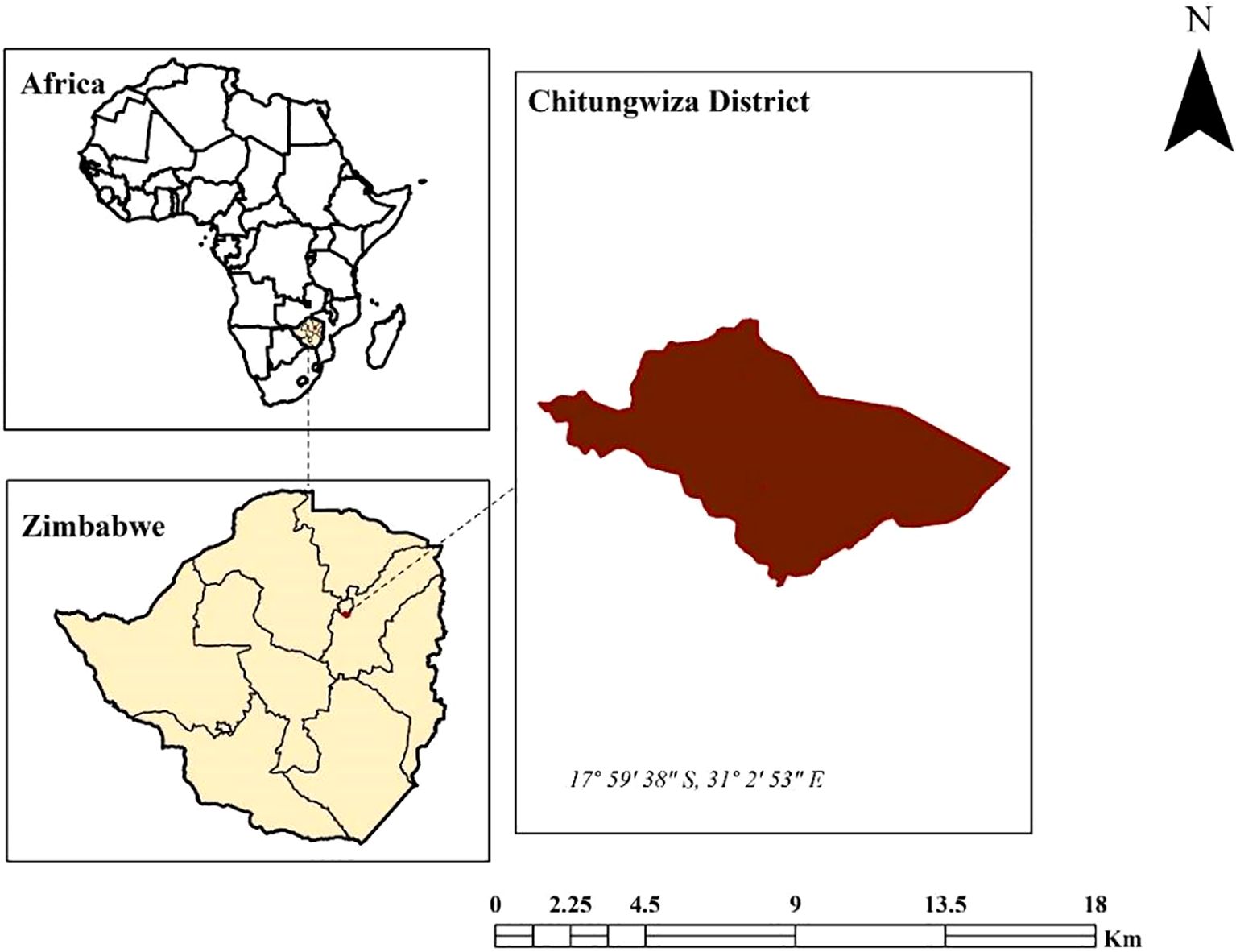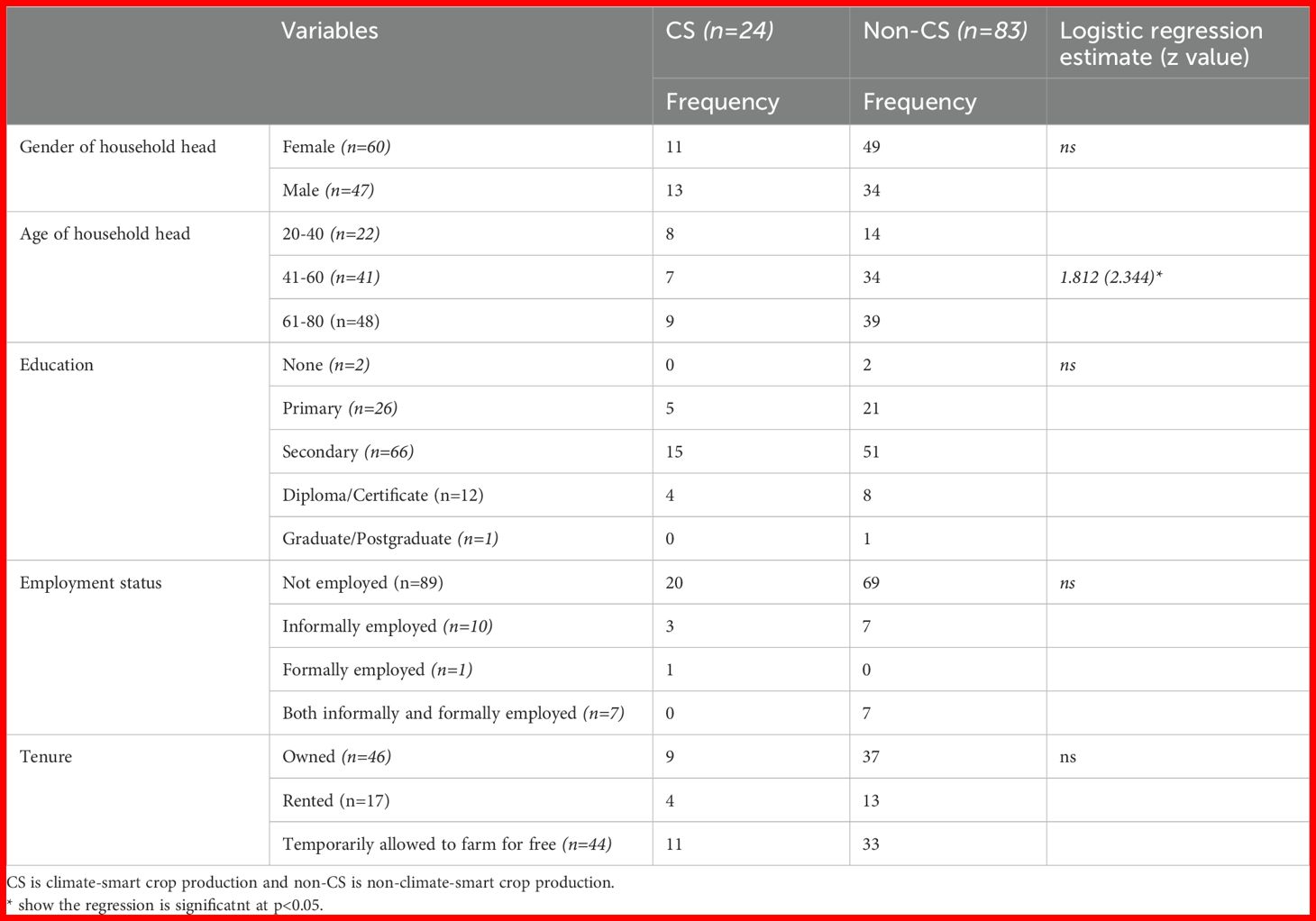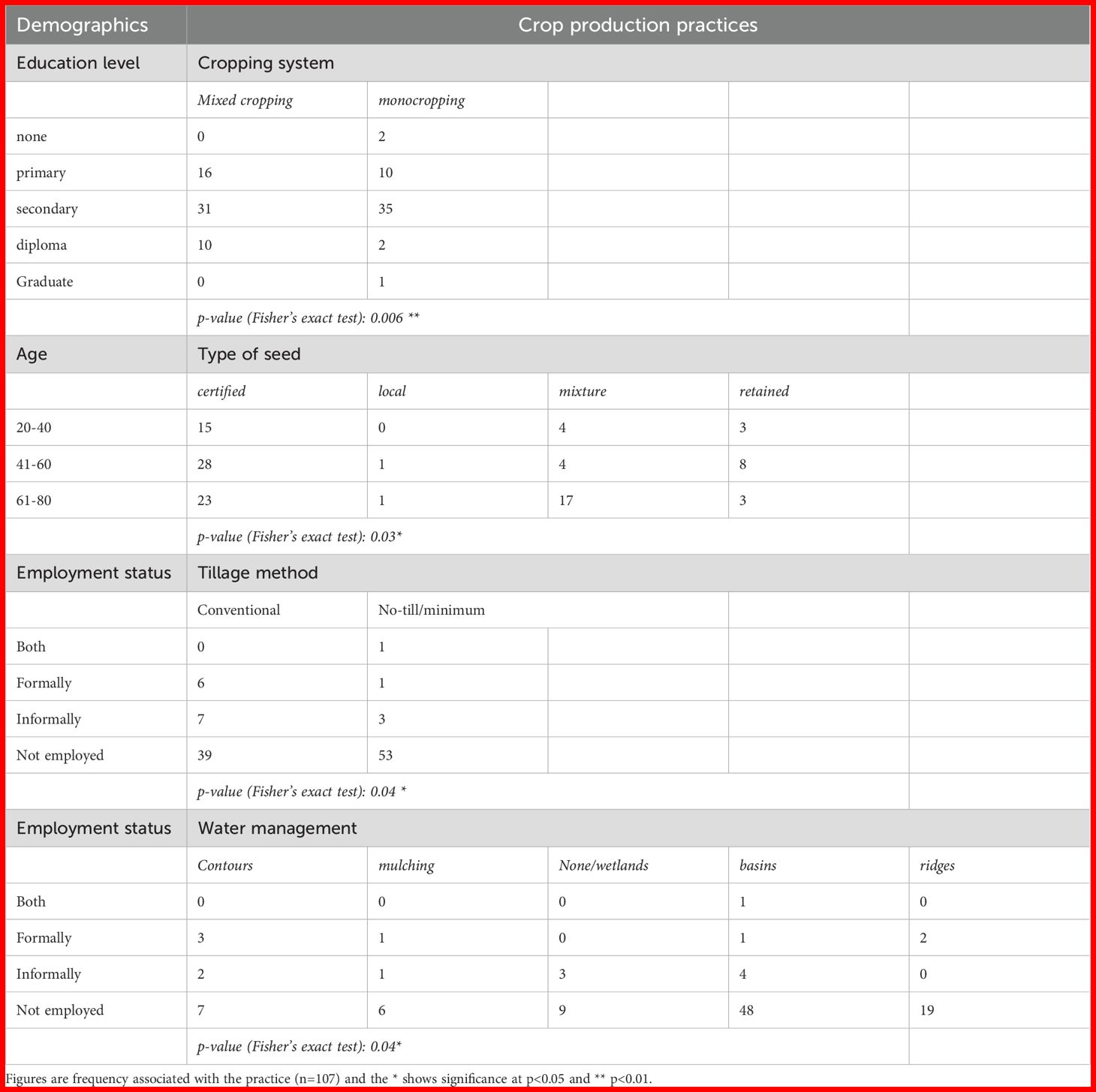- Department of Soil Science and Environment, University of Zimbabwe, Harare, Zimbabwe
Introduction: Global environmental change, including climate change, has adversely affected urban smallholder farmers in producing adequate and nutritious food to meet household needs in developing countries. Adopting climate-smart agriculture (CSA) practices can contribute to mitigating this challenge.
Methods: A study was carried out to evaluate current climate-smart crop production practices by urban farmers in Chitungwiza District, Zimbabwe, and their effects on household diets. Mixed methods research using a convergent parallel design was carried out where focus group discussions were carried out with four groups of farmers of diverse composition; and 107 households were randomly selected and interviewed in 2022. Farmers were grouped as climate-smart (CS) and non-climate-smart (non-CS) based on cropping sequences, soil fertility management practices, seed selection, soil water management, and tillage practices using a matrix.
Results: Results showed that only 23% of the farmers were classified as climate-smart. The adoption of climate-smart practices was influenced by the socio-economic status of the farmers i.e., age-influenced type of seed grown (p<0.05); employment status influenced tillage method used (p=0.04) as well as water management practices (p=0.04), and education level influenced the cropping system (monocropping versus diversified; p=0.03). There were no significant differences in maize yield of CS and non-CS farmers, with CS farmers having an average maize yield of 2.10t/ha vs. 2.27 t/ha, respectively, in the 2020/2021 season. Climate-smart crop production had a positive influence on household diets with CS households having a significantly higher Household Dietary Diversity Score (HDDS) than that of non-CS farmers (3.3 vs. 2.9; p=0.02).
Discussion: We concluded that the adoption of climate smart agronomic practices in urban agriculture positively impacts food and nutritional outcomes for urban communities thus contributing to the United Nations Sustainable Development Goal 2 of reducing hunger and poverty by year 2030.
1 Introduction
By the year 2030, approximately 60% of the world’s population is predicted to live in urban cities (United Nations, Department of Economic and Social Affairs, Population Division, 2018). This rapid urbanization has pressured urban environments to provide ecosystem services, including the provision of food, feed, fuel and fiber. Therefore, in most developing countries, increased urban food insecurity and poor diets have become critical concerns as more people move to urban areas (Szabo, 2016; Putra et al., 2020; Ngcamu, 2022). Studies show that urban communities experience food insecurity at four levels. The national level, where excess food is limited nationwide due to challenges with imports or policy, and many nations push for an increase in production (Warr, 2014; Ashby et al., 2016). Food insecurity can be experienced at household and individual levels based on the ability to grow and buy their own food and knowledge on dietary diversity and crop diversification (Barrett, 2010). Insecurity can also result from temporal changes such as variation in climate, economic stability and outbreak of pests and diseases (Ayalew et al., 2024). Consequently, sustainable food production in and around cities is an important strategy to meet household food self-sufficiency and build resilience, particularly in major cities in sub-Saharan Africa (Langemeyer et al., 2021). Evidence from literature shows the growing importance of urban and peri-urban agriculture in reducing food insecurity in urban systems through the supply of cereals for home consumption and better nutrition (Cofie et al., 2003). A study carried out in Zimbabwe showed that 22.3% of households in urban areas practiced agriculture, and the figure can increase to 46% in areas where climatic conditions are favorable for crop production (ZimVAC, 2023).
Urban agriculture (UA) covers agricultural activities located in urban or on the fringe (peri-urban) of a city or town, which reflect the local context, and the aim is to enhance urban sustainability (Sarker et al., 2019). Throughout the world, UA is practiced and its share of the global food sector is approximately 25-30% (Senyolo et al., 2021). It is estimated that 230 million urban dwellers in Africa and 130 million in Latin America practice gardening, producing not only for family consumption, but also as a source of income (Korir et al., 2015; Sarker et al., 2019). Urban food production can play a vital role in meeting many of the food security challenges in urban communities, particularly in developing countries thereby building greater resilience of the urbanites to climate change and other shocks and stresses.
In the wake of climate change, characterized by erratic rainfall, droughts, and increased prevalence of pets and diseases and other stresses, urban food production has not been spared and has seen a reduction in crop yields in recent years (Vermeulen et al., 2012). Against this background, adoption of climate-smart agriculture (CSA) as an adaptation and mitigation strategy in UA to support food and nutrition security has become increasingly important (Chitakira and Ngcobo, 2021). CSA is an approach anchored on three pillars namely (i) sustainably increasing agricultural productivity and incomes, (ii) adapting and building resilience to climate change, and (iii) reducing and/or removing greenhouse gases emissions (FAO, 2013). To cope with the changing climate, urban farmers are already experimenting with a number of agronomic techniques with some of the options culminating into crop yield and soil health benefits (Nyamasoka et al., 2015).
Conservation agriculture (CA), precise fertilizer application, use of organic nutrient sources, crop rotation, and intercropping, use of drought-tolerant crops, precision irrigation and agroforestry are some of the commonly-promoted CSA practices in SSA (FAO, 2013; Chitakira and Ngcobo, 2021). Conservation agriculture consists of three principles, which are permanent soil cover, minimum soil disturbance, diversified crop rotations, and integrated weed management along with other good production practices of plant nutrition and pest management. It conserves natural resources and the environment for improving and sustaining crop productivity (Farooq and Siddique, 2015). Previous assessments in Zimbabwe have shown that there are different climate-smart crop production options used by farmers. These include CA (commonly promoted as Pfumvudza/Intwasa), use of quality certified seeds, use of community seed banks, use of adapted improved seed, growing of traditional cereal crops, use of compost/organic fertilizer, use of drip irrigation, intercropping, cover cropping and mulching.
Climate-smart agriculture plays an important role in enhancing the food and nutritive security of urban communities. As highlighted in the previous paragraphs, CSA improves the resilience of the urban communities by allowing the crops to cope in the advent of drought, unpredictable rainfall and increased pests and diseases (Lipper et al., 2014). In addition, diversified food sources can help provide alternatives in cases of some crops failing as well as a wider nutrition base for the communities. Furthermore, CSA in urban communities can also allow communities to buy food that they cannot grow from income from selling excess crops, especially vegetables and also promotes local food production leading to reduced cost to buy food (Khumalo et al., 2024; Chari and Ngcamu, 2022).
Adoption of CSA practices in urban communities is also influenced by the socio-economic status of the farmers. Studies by Mujeyi et al., 2021 in Zimbabwe showed that the adoption of CSA practices was influenced by livestock ownership, access to information and availability of labor. In another study, farm size, land tenure and education level influenced the adoption of climate smart soil fertility practices in Kenya (Mogaka et al., 2021). These studies and several others demonstrate the influence of demographics on adoption of CSA practices in smallholder farming communities but there is a paucity of information on whether similar variables would drive CSA practices in urban communities and ultimately influence food and nutrition security.
Given the increasing importance of UA, it is important to assess the extent of adoption of CSA technologies and their contribution to supporting food and nutrition security of urban households, particularly in the wake of the changing climate. Such assessments allow for identification of options for scaling up, and (re) designing of existing of CSA technologies targeted at households of varying resource endowment to ensure sustainable agricultural production within the larger context of resilient cities and food systems The objectives of this study were therefore to i) characterize climate-smart crop production practices in Chitungwiza District, Zimbabwe ii) determine the contribution of climate-smart smallholder crop production on household food and nutrition security and iii) to determine the socio-economic drivers of adoption of CSA practices. The results of this study will provide new design options for enhancing climate-smart crop production in urban and peri-urban environments, thereby supporting the sustainability and resilience of urban agri-food systems as shown in the Theory of Change framework (Figure 1).
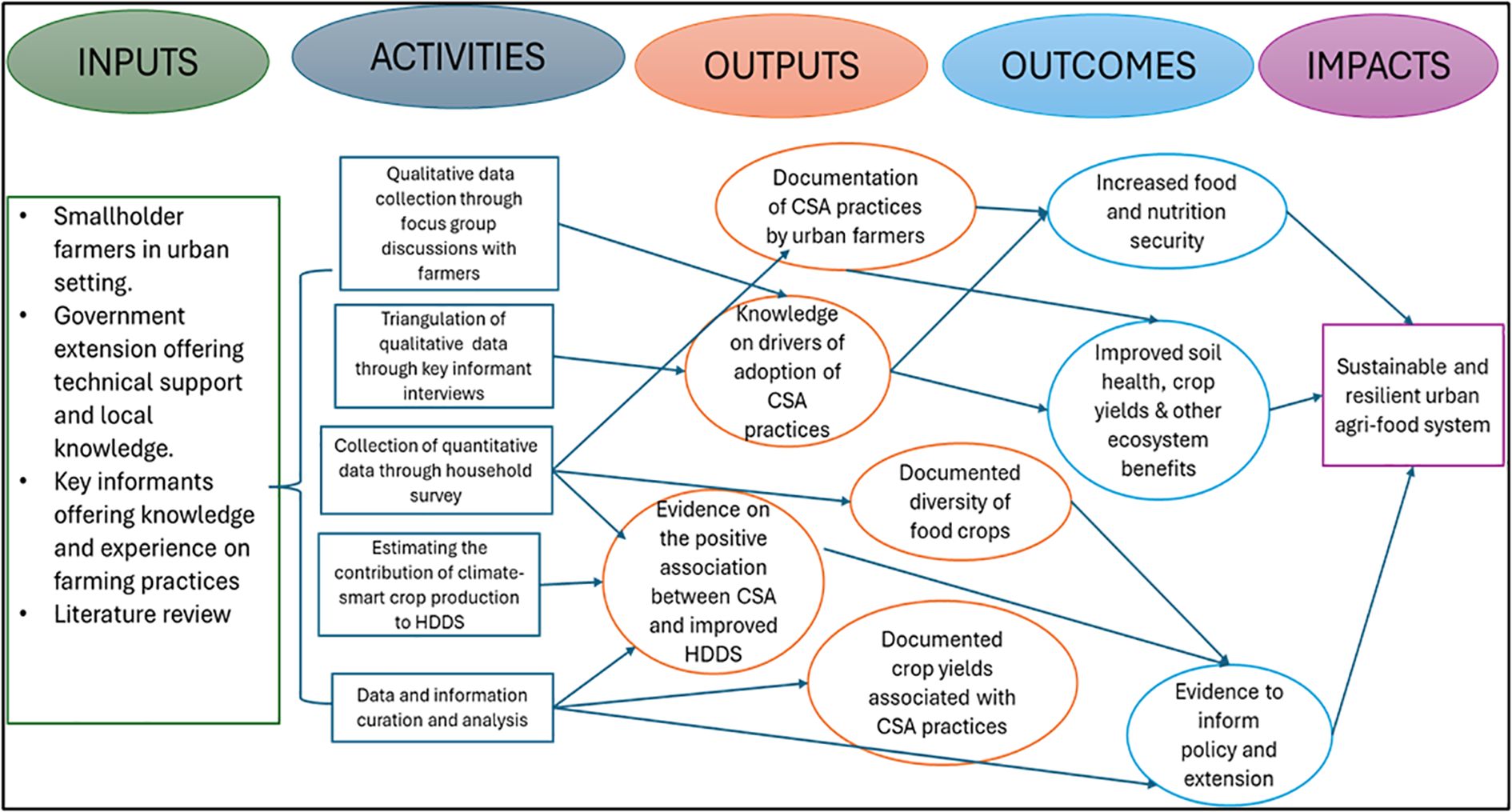
Figure 1. Theory of change conceptualized for the study (Adapted from Reddy et al., 2022).
2 Methodology
2.1 Study site
The study was conducted in Chitungwiza district (Figure 2) of Harare Province (17° 59′ 38″ S, 31° 2′ 53″ E) in 2022. The district is at 1448 m above sea level and experiences a sub-tropical climate classified as Cwb (a highland tropical climate with dry winters and hot humid summers) according to the Köppen and Geiger classification system (Rohli et al., 2016). Chitungwiza experiences a maximum temperature range of 21.8°C to 30.5°C, and a minimum temperature range of 8.3°C to 17.4°C, and a unimodal rainy season receiving an average rainfall of 800 mm between November and March (Shumba et al., 2020). This climate makes it possible to grow a variety of crops e.g. maize (Zea mays L.), beans (Phaseolus vulgaris L.), sweet potatoes (Ipomea batatas (L.)), groundnuts (Arachis hypogaea L.), and leafy vegetables such as Brassica juncea and Brassica napus and tomatoes (Lycopersicon esculentum).
The soils in Chitungwiza District are predominantly classified as Ferrallitic Cambisols (coarse-grained sandy soils) according to the World Reference Base for Soil Resources (FAO, 1998). These soils are generally considered poor in fertility due to low organic matter and poor nutrient retention. However, some areas are also covered by the more fertile vertisols (black expansive 2:1 clays). The vertisols are mostly found in dambos where farmers grow vegetables for the urban markets of cities of Chitungwiza and Harare.
The district represents one of the most vulnerable of the urban population (ZimVAC, 2020) and has a high rate of poverty, with many of the people relying on urban agriculture to supplement their incomes and household food security (Chihambakwe et al., 2019).
2.2 Overall study approach
The study was carried out using an exploratory sequential design of mixed methods research where qualitative (focus group discussions and key informant interviews) were conducted and followed up with quantitative (household questionnaire survey) assessment (Cameron, 2009).
2.2.1 Focus group discussions and key informant interviews
Five focus group discussions (FGDs) were conducted with participants drawn from four wards in Chitungwiza. In Zimbabwe, a ward is the smallest planning and administrative unit headed by a councilor. Each focus group comprised a mixed group of 11 or 12 farmers, divided roughly equally by gender and a mix of age groups (from 21 years to 69 years). The groups were not disaggregated by gender or age, as no specific gender focus was expected. In addition, some authors also argue that mixing groups might provide a more balanced insight depending on the study focus (Nyumba et al., 2018). The participants were selected using purposive/convenience sampling with the help of extension workers. Notes were taken in local languages and later translated into English. The discussions (∼2 h each) centered on characterizing climate-smart crop production practices in Chitungwiza District and were guided by the following themes: cropping practices, soil fertility management, tillage practices, seed type selection, and soil water management (Supplementary Appendix 1). Focus group discussions allow for consensus building and triangulation of information and are effective at collecting qualitative data in smallholder farming communities (Gill et al., 2008). Key informant interviews involved interviews with four extension officers who were selected based on their knowledge and experience as extension service providers in the area. Key informant interviews were used to collect data on the climate-smart crop production practices employed by the households and communities, as well as local perceptions about the use of CSA practices by farmers (Supplementary Appendix 1).
2.2.2 Household questionnaire survey
A structured pre-coded household questionnaire (Supplementary Appendix 2) was used to collect information on CSA crop production practices and household food security. The survey instrument was pre-tested in the field using five households and adjusted accordingly where there were concerns, as Willis (2016) suggested.
Following pretesting, the sample size was selected from a list of households involved in agricultural activities in the four wards in the Agricultural Advisory Services (ARDAS) extension workers' records. ARDAS is the national extension department of the government of Zimbabwe responsible for offering advisory services and training of farmers in rural and urban areas. The Raosoft sample size calculator (Raosoft, 2010) was used to come up with a sample size of 107 households using a margin of error of 90%; a confidence interval of 95%, and a response distribution of 50% using the formula calculated from Equation 1:
Where n’ is the sample size for a finite population and; n is the sample size for an unlimited population calculated from Equation 2;
and; z is the z score for a 95% confidence interval; ϵ is the margin of error assumed at 10%; N is the population size of the farmers in the records of extension officers in the 4 wards (~5 000) and pˆ is the population proportion or response distribution assumed at 50%.
Simple random sampling was used to select the households from the list provided by the extension workers by selecting every.ith household on the list (Latpate et al., 2021). The period of data collection was in October and November 2022 to coincide with the lean period during which households often face difficulties in accessing food and feed resources.
The climate-smart crop production practices carried out by the farmers in the study were grouped into 5 main categories i.e., tillage practices, soil fertility management, type of seeds and crops, soil water conservation, and cropping systems (Table 1).
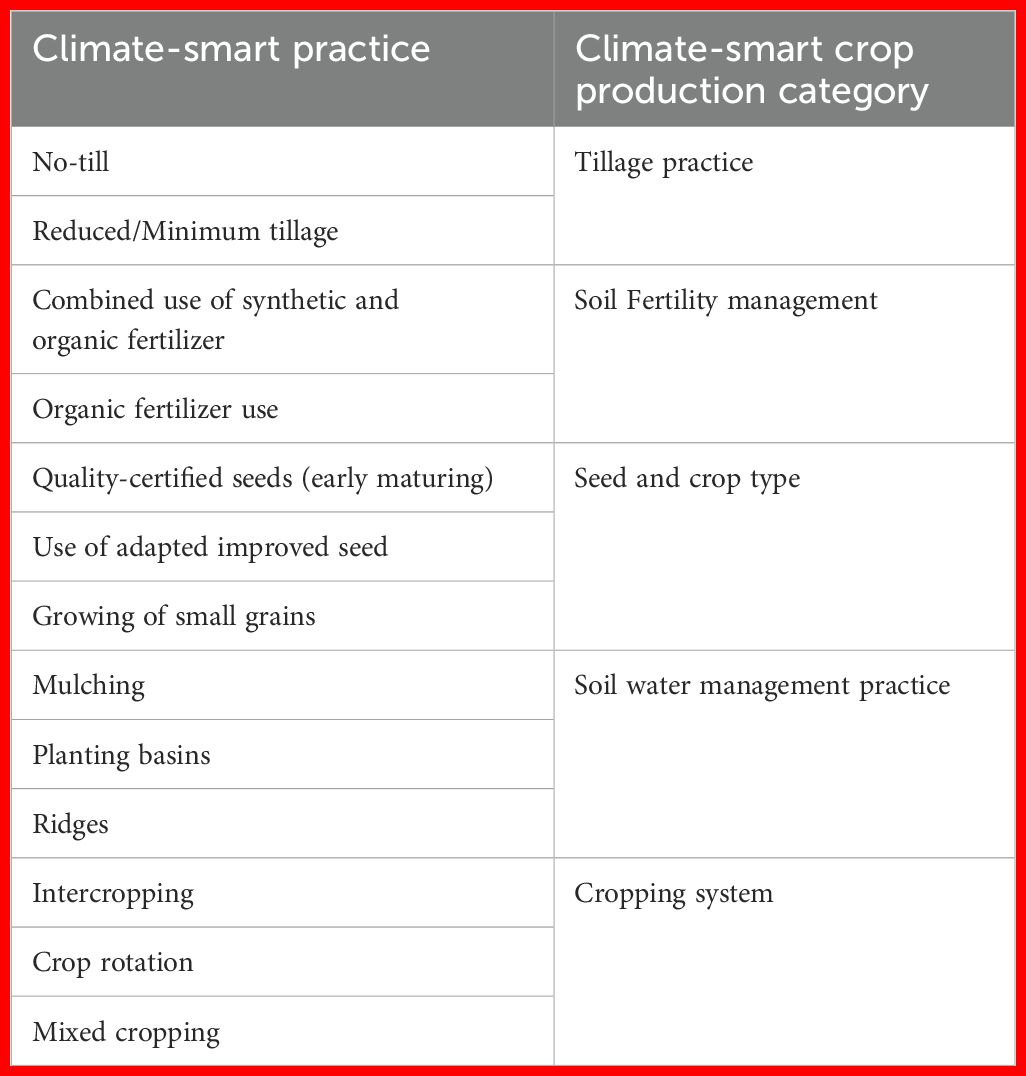
Table 1. The categories of crop production climate-smart practices used by urban smallholder farmers in Chitungwiza District.
Households were then grouped into climate-smart (CS) and non-climate-smart (non-CS) using a criterion where a household was considered climate-smart if carrying out any one climate-smart crop production practice in each of the climate-smart production categories shown in Table 1 as expressed by the syntax below in Box 1 according to methods by Mapfumo et al. (2022):
Box 1. If {combined synthetic and organic fertilizer use OR organic fertilizer use = 1} and {crop rotation OR mixed cropping OR intercropping= 1} and {reduced/minimum tillage practices OR no tillage = 1} and {mulching OR planting basins OR ridges= 1} and {use of quality certified seeds (early maturity) OR use of adapted improved seed OR growing of small grains =1} then the crop production undertaken is considered climate-smart.
where: 1= undertaking of the practice, and 0 = not implemented by the household.
2.2.3 Estimating the contribution of climate-smart crop production on Household Dietary Diversity score
During the survey, the farmers were asked to record the foods they ate within 7 days of this period. Data were collected from those categorized as climate-smart farmers (n= 24) as well as those categorized as non- climate-smart farmers (n=83). The food was put into 3 categories: foods that were harvested or obtained from their fields ‘own production’ and those they purchased or given as gifts. A modified plant-based household food dietary diversity score (HDDS) was calculated according to methods by Kennedy et al. (2011) where crop/plant-based food was grouped into 5 core food categories i.e., A=cereals; B=roots and tubers; C= vegetables; D= fruits; E= legumes/pulses and each food group was assigned a score of 1 (if consumed) or 0 (if not consumed). The average HDDS for each household was computed by dividing the sum of the food groups by the number of days when the data was collected (7 days) see Equation 3:
Where HDDS is diversity dietary diversity score for each household; the letters are scores from consuming different foods i.e., A=cereals; B=roots and tubers; C= vegetables; D= fruits; E= legumes/pulses and, i.e., 1 (if consumed) or 0 (if not consumed); and d is the number of days of collection of the data which was 7 is this case. The household dietary diversity score for each of the groups (CS and non-CS) was then calculated by adding the sum of all the HDDS scores in each group and dividing by the total number of households surveyed in that group as follows (Equation 4):
Where Group HDDS is the diversity dietary diversity score for each group (CS and non-CS); HDDS is the diversity dietary diversity score for each household in each of the groups and n is the total number of households in that group.
2.3 Data analyses
Qualitative data generated through the in-depth key informant interviews and FGDs were analyzed using manual thematic analysis (Saldaña, 2021) and in the qdap package (Rinker, 2023) in R statistical software v 4.3.2 (R Core Team, 2011). A deductive approach was used to analyze content based on the following themes: cropping practices, soil fertility management practices, seed type, soil water management, and tillage practices, as these are the climate-smart crop production categories considered in the study.
Quantitative data was analyzed using R statistical software. Fisher’s exact test of association between household demographics and climate-smart production, and two sample t-tests to analyze differences in means between CS and non-CS groups for maize yield and household dietary diversity scores (HDDS). Assumptions for two-sample t-test i.e., normal distribution was tested using QQ plots; the presence of outliers was tested using Cook’s distance (Di) where points with a Di of greater than 1 were considered outliers and removed from the analysis (Stevens, 1984); and homogeneity of variance between the two groups was tested using Levene’s test (Glass, 1966).
3 Results
3.1 Diversity of crops produced in Chitungwiza District
Farmers in Chitungwiza District grew a variety of crops mainly from five (5) food groups namely cereals, roots and tubers, vegetables, fruits and legumes/pulses (Figure 3). The most grown food groups were cereals and vegetables with all the farmers growing the staple crop maize (Zea mays L). Over 50% of the farmers grew leafy vegetables such as mustard rape (Brassica juncea), common rape (Brassica napus), covo (Brassica oleracea), spinach (Spinacia oleracea) and other vegetables such as onions (Allium cepa) and tomato (Lycopersicon esculentum). These vegetables were commonly grown in wetlands near rivers or streams or in household vegetable gardens with irrigation using wastewater from the household or ground sources. Less than 30% of the farmers produced legumes and pulses as well as roots and tubers. The most produced fruit was mango (Mangifera indica) (46%) followed by guava (Psidium guajava) and avocado (Persea americana) (20% each, respectively).
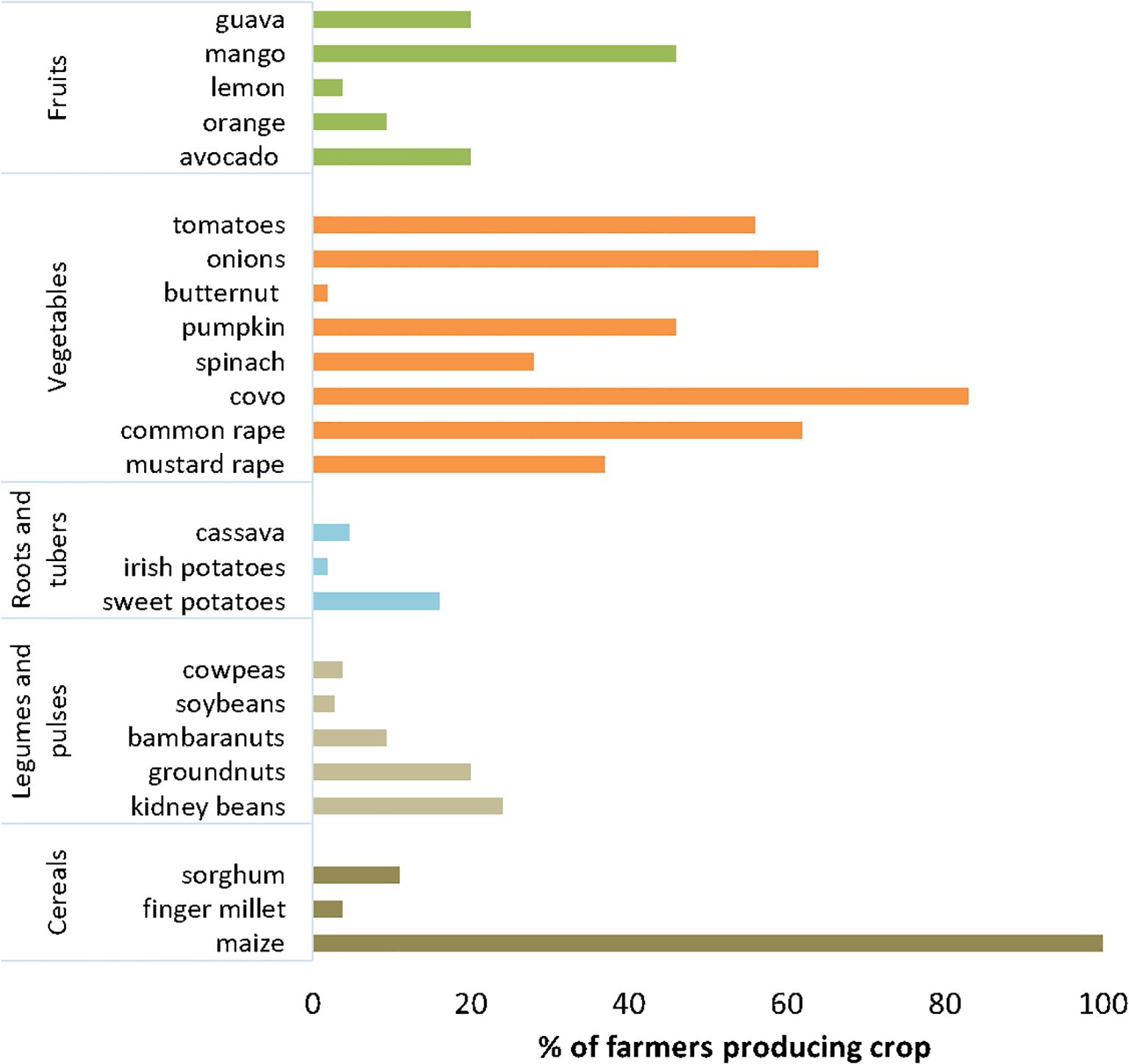
Figure 3. Variety of crops grown and frequency of production by urban farmers in Chitungwiza district.
3.2 CSA production practices and farmers’ perceptions
Results showed that crop diversification i.e., mixed cropping/rotations/diversification was practiced by 53% of the farmers. Of those, 46% reported that crop diversification contributed to an increase in maize grain yield (Figure 4a; Quote 2), 45% noted improved household nutrition and diets (Figure 4a; Quote 1) and 1% did not perceive any benefit from the practice. Of the 52% of households that practiced no-till/minimum tillage, 82% perceived that it led to increased yields (Figure 4b; Quote 20 and 24). Most farmers (71%) practiced climate-smart soil fertility management practices in the form of combined application of mineral and organic fertilizers or organic inputs only and/or cereal-legume rotations. Of those, 84% noted that climate-smart soil fertility management practices led to an increase in crop yield, while 11% reported it improved nutrition and diets (Figure 4c; Quote 7). There was an array of soil water management practices employed by the farmers, for example planting basins (Pfumvudza/Intwasa basins), contour ridges and mulching. Most of the farmers (85%) cited an increase in crop yields due to less wilting and drying of crops (Figure 4; Quote, 16 and 18) as a result of soil water management practices. Other benefits of the CSA practices as alluded by farmers included less pests and diseases in fields where CSA is practiced (Supplementary Table S1, Quote 4) and having assured yield from short-season crop varieties bought from retail shops (Supplementary Table S1, Quote 11). In addition, other CSA practices included the use of improved seed varieties or use of locally adapted varieties by about 75% of the farmers and avoiding the use of pesticides and herbicides (only 16% used chemicals). The farmers have also adopted management practices such as staggered planting (24%), water harvesting (5%), irrigation (19%) and growing drought-tolerant plants (24%). However, farmers also cited several challenges in the adoption of CSA practices. For example, the farmers said they do not apply adequate rates of organic nutrient resources as they do not have the money to buy externally nor do they have animals to produce manure on-farm (Supplementary Table S1, Quotes 5,6, and 8); and that some of their land is bigger than the resources available (Supplementary Table S1 (Quote; 9). Some of the reasons cited for not using no till or minimum tillage methods include bigger land sizes compared to the labor available (Supplementary Table S1, Quote 22,23 and 24).
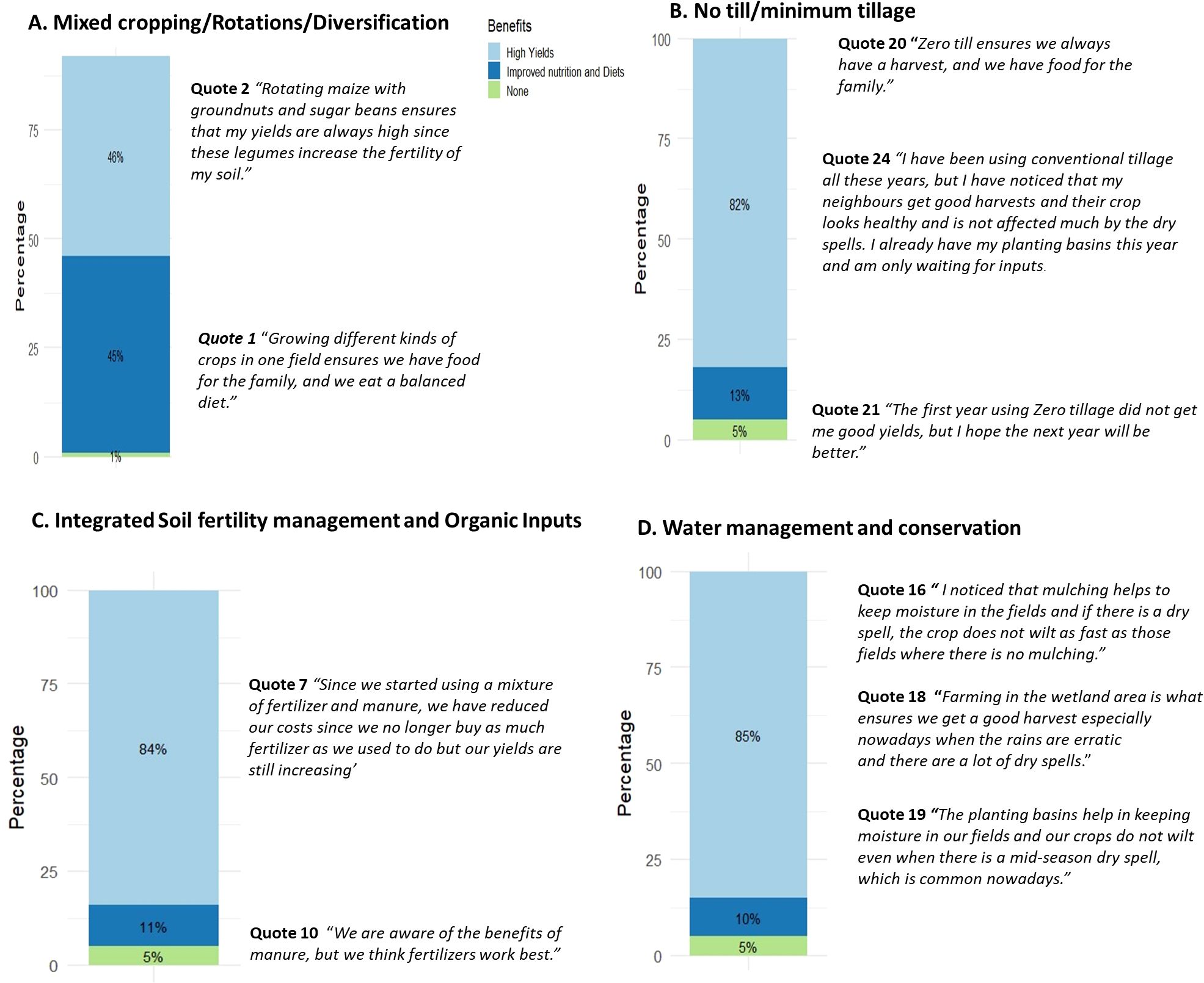
Figure 4. Selected climate-smart crop production practices (A-mixed cropping; B-no till or minimum tillage; C-soil fertility management and D-water management) and farmers’ perceptions following an interview of 107 farmers and Focus group discussions in Chitungwiza District. The quotes were drawn from mixed focus group discussions held in Ward 2 (Quotes 7 and 18), Ward 4 (Quotes 24, 2, 1 and 7), Ward 8 (Quotes 10 and 21) and Ward 6 (quotes 19 and 16) and Ward 16 (Quote 20) of Chitungwiza District.
3.3 Association of household demographics and climate-smart production practices
While most of the farmers adopted one or more CSA practices, only 23% (n= 24) practiced all the agricultural practices that are termed “climate-smart” and constituted climate-smart (CS) farmers as described by the classification in Box 1. Only age (41–60 years) was significantly associated with greater odds of practicing CSA (p=0.019); Table 2.
However, the households practiced one or more CS production which was influenced by demographics and other socio-economic and socio-cultural factors. For example, education level significantly influenced the type of cropping systems (p=0.006). Most farmers with post-secondary education practiced mixed cropping (Table 3). Age significantly influenced the choice of seed type planted (p=0.03) with the older farmers of 61–80 years using a mixture of seeds i.e. retained, local landraces and certified seeds, while the younger farmers used certified hybrid seeds (Table 3). Employment status influenced the water management (p=0.04) and tillage (p=0.04) practices where farmers who were not employed largely practiced no-till or reduced tillage methods compared to employed farmers who mainly practiced conventional tillage (Table 3). Land tenure (ownership) and gender did not significantly influence any of the CSA production practices.
3.4 Diversity of crops produced and contribution of climate-smart crop production to household food and nutrition security
Since maize is the staple and most grown crop in Zimbabwe, we looked at the yield over two growing seasons (Figure 5). Maize yield was on average low (average < 2.5 t/ha) for all farmers. In addition, there was no significant difference in maize yield between the CS and non-CS farmers in the 2019/2020 season (1.78 t/ha vs 2.10 t/ha) and the 2020/2021 season (2.10t/ha vs 2.27 t/ha), respectively. Over 80% of the farmers (n=86) reported that the maize produced was enough for family consumption for a period of 7 to +/-12 months.
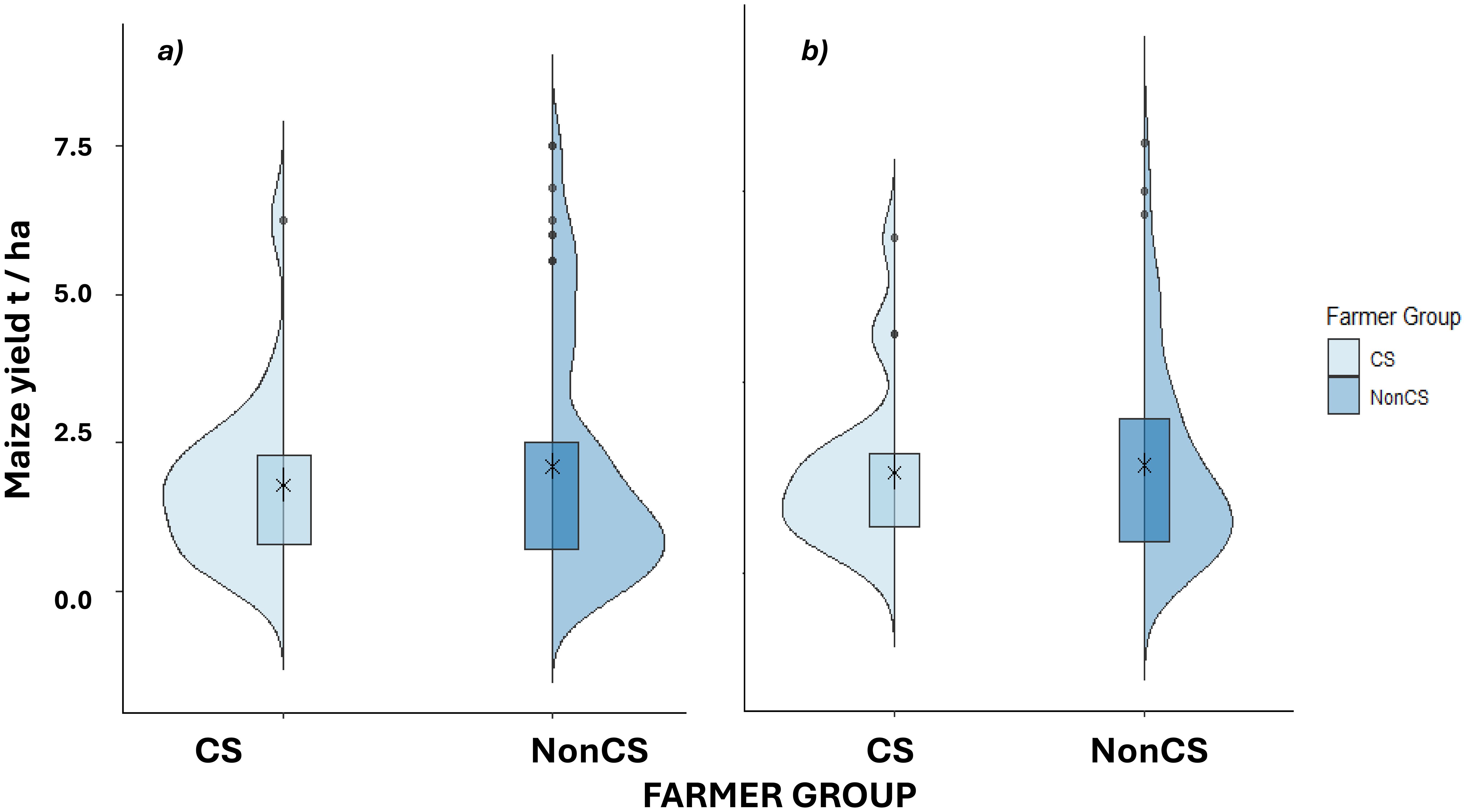
Figure 5. Maize yield produced by climate-smart farmers (CS) and non-climate smart farmers (non-CS) over two seasons (a; 2019-2020 and b; 2020-2021) in Chitungwiza district, Zimbabwe.
More than 50% of the cereal, vegetables, and legumes consumed in CS households came from own production (Figure 6a), while for non-CS farmers most of the legumes consumed were purchased externally (Figure 6b). For CS farmers, there was an equal percentage of roots and tubers consumed from own production and that which was purchased, while non-CS farmers consumed more roots and tubers purchased externally than produced on- farm. For both CS and non-CS farmers, more than 50% of the fruit consumed was bought from retail shops.
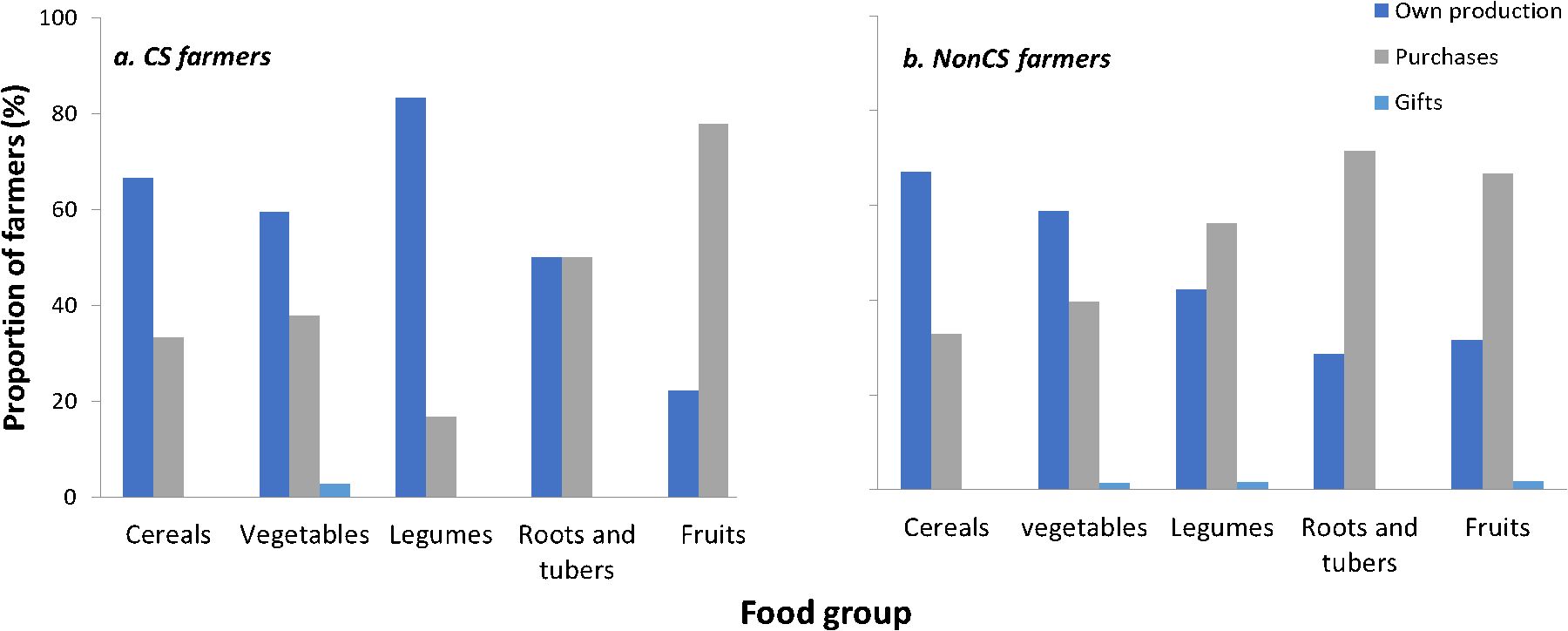
Figure 6. Plant based food groups consumed by (a) climate-smart (CS) farmers and (b) non climate-smart (NonCS) farmers in Chitungwiza District, Zimbabwe.
The accumulated HDDS of CS farmers calculated for a seven-day period was higher than that of non-CS farmers (3.3 vs 2.9; p-value<0.02) (Table 4).

Table 4. Household Dietary Diversity Score based on 7 food groups produced on farm for urban farming households in Chitungwiza District, Zimbabwe.
4 Discussion
4.1 Climate-smart crop production practices by urban farmers in Chitungwiza District
Climate-smart crop production relates to the integration of cropping systems and management systems such as improved use of inputs like seeds, chemicals, and water. Our study shows that farmers practiced one or more climate-smart strategies. Crop diversification has well-documented benefits to the soil and can positively influence climate change adaptation (i.e., reducing the risk of crop failure) and mitigation i.e., returning carbon to the soil (Islam et al., 2018; Giller and Cadisch, 1995). However, for the farmers practicing mixed cropping or crop rotations, their motivation is not always climate-related as noted in this study and others, but the need to diversify their food systems, increase yield, and control pests and diseases (Omokaro et al., 2023; Rusinamhodzi et al., 2012). Some farmers, however, still resort to monocropping which is a practice of planting a single crop (maize- in most cases in Zimbabwe) on the same piece of land for years. This has been shown to negatively affect soil health as it leads to acute nutrient mining leading to more chemical fertilizer use as well as increased loss of soil carbon (Belete and Yadete, 2023). Despite the negative impacts of monocropping, farmers still practiced it as it is ingrained in their norms, and research shows that farmers do not easily deviate from cultural norms of crop production (Nyamasoka-Magonziwa et al., 2021). Farmers with post-secondary education mostly practiced crop diversification as they are better equipped with the knowledge of the advantages of these practices. Evidence from other studies has shown a positive association between the level of education and the adoption of climate-smart crop production systems (Saha et al., 2019; Li et al., 2024).
Reduced or no-till is being promoted in farming systems worldwide as it is purported to reduce greenhouse gas emissions from the soil by maintaining soil carbon (Ogle et al., 2019). In Chitungwiza, no till in being promoted through the Pfumvuza/Intwasa program, a conservation agriculture-based initiative of the government of Zimbabwe (Mujere, 2021; Tanyanyiwa et al., 2022). This practice has been passively adopted in the communities following the extension programs. Some studies have further shown that no-till can lead to an increase in crop yields compared to conventional tillage systems (Mujere, 2021), which agrees with the view of the farmers who practice this strategy in this study. Despite farmers observing an increase in yield as a benefit of adopting not till, some studies have shown that no-till leads to yield reductions or matches the yields obtained from conventional tillage (Pittelkow et al., 2015) or leads to modest yield increases under certain conditions (rainfed or mulching). Furthermore, our results showed that the adoption of reduced till, or minimum tillage, was associated with unemployment. This concurs with a study carried out by Tadjiev et al. (2023) who noted that unemployed farmers tended to favor no tillage or minimum tillage as it reduced total production costs by 15% compared to conventional tillage.
The use of organic inputs is another strategy that is considered climate-smart due to the return of carbon to the soil and reduced use of mineral fertilizers. Most farmers also noted that this practice led to an increase in crop yields compared to the application of synthetic fertilizers. This concurs with a meta-analysis done by Wei et al. (2020) where they noted a 4.22% increase in maize yield when substituting mineral nitrogen with organic nutrients at the same nitrogen rate. However, organic nutrient sources available to the farmers are too low to satisfy the recommended nutrient application rates, resulting in poor crop yield response. The farmers affirmed this by citing a lack of livestock ownership and resources to buy manure from external sources. Therefore, it is important to give the context under which the use of organic resources leads to more yields compared to mineral fertilizers. In addition, further investigations must be done on other benefits apart from yield such as improvement of taste and quality of vegetables and fruits produced under organic inputs (Rahman et al., 2021) which can lead to adoption on that basis. A small number of farmers from this study (5%), however, believed that mineral fertilizers increased crop productivity better than organic nutrient resources. Management of inputs such as seed, chemicals, and water are critical for climate change adaptation and mitigation. Most farmers using certified seeds (improved varieties) were considered climate-smart. However, older farmers (61–80 years) used a mixture of seeds that are certified as well as local and retained seeds. It is noted that very few farmers use pesticides and herbicides which can contribute to greenhouse gas emissions.
Climate-smart crop production is used to describe a range of strategies for adapting and mitigating climate change while improving food security (Chandra et al., 2018; van Wijk et al., 2020). However, despite most of the farmers practicing at least one strategy, only a quarter were classified as climate-smart according to the index developed in this study. This index is such that the farmer should practice at least one of the practices for the improvement of soil health, crop productivity, use of improved seeds, reduced or minimum tillage, and water management to realize the benefits of climate-smart crop production. Selective adoption of some mitigation and adaptation measures may result in some farmers not realizing all the climate-smart agriculture benefits. However, it might not be possible for farmers to adopt many strategies and so there should be ways to maximize each strategy even as it is adopted on its own.
4.2 A variety of crops are produced in Chitungwiza, and climate-smart production contributes positively to Household Dietary diversity
Farmers in Chitungwiza grow a variety of crops, as in most urban areas, showing that urban food production can significantly contribute to food security in smallholder production systems (Steenkamp et al., 2021). However, our findings show that while a variety of crops are grown, farmers mainly grow maize, which is the staple crop, as well as leafy vegetables. This is because the diet of the local people in Chitungwiza consists mainly of sadza (from maize meal) and vegetables. The implication of this is the lack of nutritive security as this diet lacks adequate protein from sources such as beans and nuts which are grown by a small proportion of farmers, or vitamins and minerals from sources such as fruits. Fruits provide minerals such as zinc from avocados, calcium from oranges and guavas, and magnesium in bananas, and peaches which may help in the prevention of osteoporosis and rickets caused by calcium deficiency and anemia caused by iron deficiency (Kirby and Danner, 2009). This concurs with Davies et al., 2021 following a study in Zambia and Kenya which showed that there was a lack of a strong relationship between urban food production and urban food security.
The modified HDDS for CS farmers was significantly higher than that of non-CS farmers. This is consistent with a study in Mozambique where conservation agriculture significantly increased the Food Consumption Score for farmers exposed to the technology (Mango et al., 2017). This shows that climate-smart practices ensure a diversity of food consumed. Climate-smart crop production can therefore help alleviate the prevalence of hidden hunger in communities. Hidden hunger is defined as the prevalence of multiple micronutrient deficiencies especially zinc, iron calcium, and vitamin A which occurs due to consumption of energy-rich diets (Lowe, 2021).
Most farmers have enough maize for household consumption to last them most parts of the year even though the yields are low (< 2 t ha-1). However, very few produce extra for sale to get income for other urban livelihood expenses such as payment of rent, utilities, fees, and transport considering most of the farmers are not formally employed. Moreover, cereal production is not diversified as very few farmers produce traditional cereal crops (e.g. finger millet and sorghum) meaning that there is a risk of food insecurity in years where the rainfall patterns do not support good maize growth or if pests and diseases become rampant. For example, the outbreak of the fall armyworm in Zimbabwe resulted in low maize yields, including urban areas (Nyamutukwa et al., 2022; Tambo et al., 2020). Studies show that climate change will cause a 3°C increase in annual temperature and up to 18% reduction of rainfall by the end of this century in Zimbabwe (Brazier, 2015) meaning the drive toward adoption of traditional cereal crops for climate change adaptation is very urgent. Traditional cereal crops are known to be drought tolerant due to their physiological makeup and are more resistant to pests and diseases compared to maize crops (Phiri et al., 2019). Moreover, these crops have been shown to contain several minerals such as potassium, zinc, iron, calcium, and copper that can improve the nutritional quality of household diets (Paiva et al., 2017).
5 Conclusion and recommendations
Several insights can be derived from the empirical findings of this study. Firstly, there is evidence of urban agriculture as being a source of livelihood for the people in urban areas. This shows the need to ensure that urban agriculture practices are sustainable and production is beyond just subsistence. However, the low level of adoption of sustainable agricultural practices displayed by the farmers in Chitungwiza might be due to insecure tenure arrangements among the farmers with 57% not having permanent tenure and so farmers will have limited initiative to capitalize on more sustainable practices such as the CSA.
We conclude that urban farmers should diversify and adopt climate-smart practices such as mixed cropping, intercropping, and crop rotation for better food and nutrition security.
Data availability statement
The raw data supporting the conclusions of this article will be made available by the authors, without undue reservation.
Author contributions
BN-M: Formal analysis, Methodology, Supervision, Visualization, Writing – original draft, Writing – review & editing. ES: Conceptualization, Data curation, Investigation, Methodology, Writing – original draft. HN: Conceptualization, Supervision, Validation, Writing – review & editing.
Funding
The author(s) declare that no financial support was received for the research and/or publication of this article.
Acknowledgments
We appreciate the farmers and extension officers in Chitungwiza District who enabled data collection to be carried out.
Conflict of interest
The authors declare that the research was conducted in the absence of any commercial or financial relationships that could be construed as a potential conflict of interest.
Publisher’s note
All claims expressed in this article are solely those of the authors and do not necessarily represent those of their affiliated organizations, or those of the publisher, the editors and the reviewers. Any product that may be evaluated in this article, or claim that may be made by its manufacturer, is not guaranteed or endorsed by the publisher.
Supplementary material
The Supplementary Material for this article can be found online at: https://www.frontiersin.org/articles/10.3389/fagro.2025.1394893/full#supplementary-material
References
Ashby S., Kleve S., McKechnie R., and Palermo C. (2016). Measurement of the dimensions of food insecurity in developed countries: a systematic literature review. Public Health Nutr. 19, 2887–2896. doi: 10.1017/S1368980016001166
Ayalew M. M., Dessie Z. G., Mitiku A. A., and Zewotir T. (2024). Exploring the spatial and spatiotemporal patterns of severe food insecurity across Africa, (2015–2021). Sci. Rep. 14, 29846. doi: 10.1038/s41598-024-78616-8
Belete T. and Yadete E. (2023). Effect of mono cropping on soil health and fertility management for sustainable agriculture practices: A review. J. Plant Sci. 11, 192–197. doi: 10.11648/j.jps.20231106.13
Brazier A. (2015). Climate Change in Zimbabwe: Facts for Planners and Decision Makers (Harare, Zimbabwe: Konrad-Adenauer-Stiftung Publishing).
Cameron R. (2009). A sequential mixed model research design: Design, analytical and display issues. Int. J. multiple Res. approaches 3, 140–152. doi: 10.5172/mra.3.2.140
Chandra A., McNamara K. E., and Dargusch P. (2018). Climate-smart agriculture: perspectives and framings. Climate Policy 18, 526–541. doi: 10.1080/14693062.2017.1316968
Chari F. and Ngcamu B. S. (2022). Climate change and its impact on urban agriculture in Sub-Saharan Africa: A literature review. Environ. Socio-economic Stud. 3), 22–32. doi: 10.2478/environ-2022-0014
Chihambakwe M. I., Mafongoya P. I., and Jiri O. (2019). Urban and peri-urban agriculture as A pathway to food security: A review mapping the use of food sovereignty. Challenges 10, 6. doi: 10.1186/s12998-019-0250-2
Chitakira M. and Ngcobo N. Z. P. (2021). Uptake of Climate- Smart Agriculture in peri- urban areas of South Africa's economic hub requires up- scaling. Front. Sustain. Food Syst. 5, 706–738. doi: 10.3389/fsufs.2021.706738
Cofie O. O., van Veenhuizen R., and Dreschel P. (2003). Contribution of urban and peri- urban agriculture to food security in Sub- Saharan Africa (Kyoto: Africa session of 3rd WWF).
Davies J., Hannah C., Guido Z., Zimmer A., McCann L., Battersby J., et al. (2021). Barriers to urban agriculture in Sub-Saharan Africa. Food Policy 103, 101999. doi: 10.1016/j.foodpol.2020.101999
FAO. (2013). The Food and Agriculture Organization Climate smart Agriculture Source book, Rome, Italy.
FAO/WHO Consultation on the Preparation, Use of Food-Based Dietary Guideline and World Health Organization. (1998). Preparation and use of food-based dietary guidelines: report of a joint FAO/WHO consultation (No. 880). World Health Organization, Rome Italy.
Farooq M. and Siddique K. H. M. (2015). Conservation agriculture. 1st ed (New York: Springer Internation Publishing).
Giller K. E. and Cadisch G. (1995). Future benefits from biological nitrogen fixation: an ecological approach to agriculture. Plant Soil 174, 255–277. doi: 10.1007/BF00032251
Gill P., Stewart K., Treasure E., and Chadwick B. (2008). Methods of data collection in qualitative research: interviews and focus groups. Br. Dent. J., 204 (6), 291–295.
Glass G. V. (1966). Testing homogeneity of variances. Am. Educ. Res. J. 3, 187–190. doi: 10.3102/00028312003003187
Islam A. H. M. S., von Braun J., Thorne-Lyman A. L., and Ahmed A. U. (2018). Farm diversification and food and nutrition security in Bangladesh: empirical evidence from nationally representative household panel data. Food Secur. 10, 701–720. doi: 10.1007/s12571-018-0806-3
Kennedy G., Ballard T., and Dop M. (2011). Guidelines for measuring household and individual dietary diversity (Rome: FAO).
Khumalo N. Z., Sibanda M., and Mdoda L. (2024). Implications of a climate-smart approach to food and income security for urban Sub-Saharan Africa: A systematic review. Sustainability 16, 1882. doi: 10.3390/su16051882
Kirby M. and Danner E. (2009). Nutritional deficiencies in children on restricted diets. Pediatr. Clinics 56, 1085–1103. doi: 10.1016/j.pcl.2009.07.003
Korir S. C. R., Rotich J. K., and Mining P. (2015). Urban agriculture and food security in developing countries: A case study of Eldoret Municipality, Kenya. Eur. J. Basic Appl. Sci. 2, 27–35.
Langemeyer J., Madrid- Lopez C., Beltran A. M., and Mendez G. B. (2021). Urban agriculture- A necessary pathway towards urban resilience and global sustainability? Landscape Urban Plann. 210, 1–8. doi: 10.3390/su132011498
Latpate R., Kshirsagar J., Kumar Gupta V., and Chandra G. (2021). “Simple Random Sampling,” in Advanced Sampling Methods (Springer, Singapore), 11–35.
Li J., Ma W., and Zhu H. (2024). A systematic literature review of factors influencing the adoption of climate-smart agricultural practices. Mitigation Adaptation Strategies Global Change 29, 2. doi: 10.1007/s11027-023-10098-x
Lipper L., Thornton P., Campbell B. M., Baedeker T., Braimoh A., Bwalya M., et al. (2014). Climate-smart agriculture for food security. Nat. Climate Change 4, 1068–1072. doi: 10.1038/nclimate2437
Lowe N. M. (2021). The global challenge of hidden hunger: Perspectives from the field. Proc. Nutr. Soc. 80, 283–289. doi: 10.1017/S0029665121000902
Mango N., Siziba S., and Makate C. (2017). The impact of conservation agriculture on smallholder farmers' food security in semi-arid zones of Southern Africa. Agric. Food Secur. 6, 32–39. doi: 10.1186/s40066-017-0109-5
Mapfumo P., Mapangisana T., Mtambanengwe F., MacCan S., Siziba S., Muto Y., et al. (2022). Farms in transition: agroecological farming giving families an edge in the face of declining agricultural productivity and climate stress in Bikita, Zimbabwe. Agroecology Sustain. Food Syst. 46, 1386–1413. doi: 10.1080/21683565.2022.2107596
Mogaka B. O., Bett H. K., and Karanja Ng'ang'a S. (2021). Socioeconomic factors influencing the choice of climate-smart soil practices among farmers in western Kenya. J. Agric. Food Res. 5, 100168. doi: 10.1016/j.jafr.2021.100168
Mujere N. (2021). Assessing the potential contribution of Pfumvudza towards climatesmart agriculture in Zimbabwe: A review. Preprints, 1–17.
Mujeyi A., Mudhara M., and Mutenje M. (2021). The impact of climate smart agriculture on household welfare in smallholder integrated crop–livestock farming systems: evidence from Zimbabwe. Agric. Food Secur 10, 4. doi: 10.1080/17565529.2021.1930507
Ngcamu B. S. (2022). The effects of urbanisation on food security in Africa: An overview and synthesis of the literature. Environ. Socio-economic Stud. 10, 40–48. doi: 10.2478/environ-2022-0010
Nyamasoka B., Nyamugafata P., Madyiwa S., and Nyamangara J. (2015). Urban farmer practices in soil fertility and water management and the influence of gender in Harare and Chitungwiza, Zimbabwe. Afr. J. Agric. Res. 10, 100–107. doi: 10.5897/AJAR2013.7633
Nyamasoka-Magonziwa B., Vanek S. J., Carolan M., Ojiem J. O., and Fonte S. J.. (2021). Organic nutrient source allocation and use in smallholder farming communities: what are we missing? Front. Sustain. Food. Syst. 5, 692981.
Nyamutukwa S., Mvumi B. M., and Chinwada P. (2022). Sustainable management of fall armyworm, Spodoptera frugiperda (JE Smith): challenges and proposed solutions from an African perspective. Int. J. Pest Manage. 70(2), 1–19.
Nyumba T., Wilson K., Derrick C. J., and Mukherjee N. (2018). The use of focus group discussion methodology: Insights from two decades of application in conservation. Methods Ecol. Evol. 9, 20–32. doi: 10.1111/mee3.2018.9.issue-1
Ogle S. M., Alsaker C., Baldock J., Bernoux M., Breidt F. J., McConkey B., et al. (2019). Climate and soil characteristics determine where no-till management can store carbon in soils and mitigate greenhouse gas emissions. Sci. Rep. 9, 11665. doi: 10.1038/s41598-019-47861-7
Omokaro G. O., Biokoro P. T., and Michael I. (2023). Farmers perception of practices in crop production in relation to soil health in sapele delta state. Am. J. Environ. Climate 2, 101–113. doi: 10.54536/ajec.v2i3.2218
Paiva C. L., Queiroz V. A. V., Simeone M. L. F., Schaffert R. E., Oliveira A. C. d., and Silva C. S. d. (2017). Mineral content of sorghum genotypes and the influence of water stress. Food Chem. 214, 400–405. doi: 10.1016/j.foodchem.2016.07.067
Phiri K., Dube T., Moyo P., Ncube C., and Ndlovu S. (2019). Small grains “resistance”? Making sense of Zimbabwean smallholder farmers’ cropping choices and patterns within a climate change context. Cogent Soc. Sci. doi: 10.1080/23311886.2019.1622485
Pittelkow C. M., Linquist B. A., Lundy M. E., Liang X., Van Groenigen K. J., Lee J., et al. (2015). When does no-till yield more? A global meta-analysis. Field Crops Res. 183, 156–168. doi: 10.1016/j.fcr.2015.07.020
Putra A. S., Tong G., and Pribadi D. O. (2020). Food security challenges in rapidly urbanizing developing countries: Insight from Indonesia. Sustainability 12, 9550. doi: 10.3390/su12229550
Rahman S. M. E., Mele M. A., Lee Y. T., and Islam M. Z. (2021). Consumer preference, quality, and safety of organic and conventional fresh fruits, vegetables, and cereals. Foods 10, 105. doi: 10.3390/foods10010105
Raosoft I. (2010). Sample size calculator. Available online at: http://www.raosoft.com/samplesize.html (Accessed August 8, 2022).
R Core Team (2011). R: A language and environment for statistical computing (Vienna, Austria: Foundation for Statistical Computing). Available online at: http://www.R-project.org/ (Accessed March 23, 2022).
Reddy A. A., Melts I., Mohan G., Rani C. R., Pawar V., Singh V., et al. (2022). Economic impact of organic agriculture: evidence from a Pan-India survey. Sustainability 14 (22), 15057.
Rinker T. (2023). _qdap: Bridging the Gap Between Qualitative Data and Quantitative Analysis_. R package version 2.4.6. Available online at: https://CRAN.Rproject.org/package=qdap.
Rohli R. V., Andrew Joyner T., Reynolds S. J., Shaw C., and Vázquez J. R. (2016). Globally extended Köppen–Geiger climate classification and temporal shifts in terrestrial climatic types. Phys. Geogr. 36, 142–157. doi: 10.1080/02723646.2015.1016382
Rusinamhodzi L., Corbeels M., Nyamangara J., and Giller K. E. (2012). Maize–grain legume intercropping is an attractive option for ecological intensification that reduces climatic risk for smallholder farmers in central Mozambique. Field Crops Res. 136, 12–22. doi: 10.1016/j.fcr.2012.07.014
Saha M. K., Biswas A. A. A., Faisal M., Meandad J., Ahmed R., Prokash J., et al. (2019). Factors affecting to adoption of climate-smart agriculture practices by coastal farmers’ in Bangladesh. Am. J. Environ. Sustain. Dev. 4, 113–121.
Saldaña J. (2021). Coding techniques for quantitative and mixed data. The Routledge reviewer’s guide to mixed methods analysis, 151–160.
Sarker A. H., Bornman J. F., and Marinova D. (2019). A framework for integrating in urban sustainability in Australia. Urban Sci. 32, 50. doi: 10.3390/urbansci3020050
Senyolo M. P., et al. (2021). Smallholder adoption of technology: Evidence from the context of climate smart agriculture in South Africa. J. Dev. Agric. Economics 13, 156–173. doi: 10.5897/JDAE2020.1191
Shumba A., Dunjana N., Nyamasoka B., Nyamugafata P., Madyiwa S., and Nyamangara J.. (2020). Maize (Zea mays) yield and its relationship to soil properties under integrated fertility, mulch and tillage management in urban agriculture. S. Afr. J. Plant Soil 37 (2), 120–129.
Steenkamp J., Cilliers E. J., Cilliers S. S., and Lategan L. (2021). Food for thought: Addressing urban food security risks through urban agriculture. Sustainability 13, 1267. doi: 10.3390/su13031267
Stevens J. P. (1984). Outliers and influential data points in regression analysis. psychol. Bull. 95, 334. doi: 10.1037/0033-2909.95.2.334
Szabo S. (2016). Urbanisation and food insecurity risks: Assessing the role of human development. Oxford Dev. Stud. 44, 28–48. doi: 10.1080/13600818.2015.1067292
Tadjiev A., Djanibekov N., and Herzfeld T. (2023). Does zero tillage save or increase production costs? Evidence from smallholders in Kyrgyzstan. Int. J. Agric. Sustainability 21, 2270191. doi: 10.1080/14735903.2023.2270191
Tambo J. A., Day R. K., Lamontagne-Godwin J., Silvestri S., Beseh P. K., Oppong-Mensah B., et al. (2020). Tackling fall armyworm (Spodoptera frugiperda) outbreak in Africa: an analysis of farmers’ control actions. Int. J. Pest Manage. 66, 298–310. doi: 10.1080/09670874.2019.1646942
Tanyanyiwa V. I., Kanyepi T., and Katanha A. (2022). “Zimbabwe’s pfumvudza agriculture programme—Reality or rhetoric?,” in Sustainable Agriculture and Food Security. Eds. Filho W. L., Kovaleva M., and Popkova E. (Springer, Cham: Springer), 327–347. doi: 10.1007/978-3-030-98617-9
United Nations, Department of Economic and Social Affairs, Population Division. (2018). World Urbanization Prospects: The 2018 Revision, Online Edition. Available online at: https://esa.un.org/unpd/wup/ (Accessed November 9, 2023).
van Wijk M. T., Merbold L., Hammond J., and Butterbach-Bahl K. (2020). Improving assessments of the three pillars of climate smart agriculture: current achievements and ideas for the future. Front. Sustain. Food Syst. 4, 558483. doi: 10.3389/fsufs.2020.558483
Vermeulen S. J., Campbell B. M., and Ingram J. S. (2012). Climate change and food systems. Annu. Rev. Environ. Resour. 37, 195–222. doi: 10.1146/annurev-environ-020411-130608
Warr P. (2014). Food insecurity and its determinants. Aust. J. Agric. Resource Economics 58, 519–537. doi: 10.1111/ajar.2014.58.issue-4
Wei Z., Ying H., Guo X., Zhuang M., Cui Z., and Zhang F. (2020). Substitution of mineral fertilizer with organic fertilizer in maize systems: A meta-analysis of reduced nitrogen and carbon emissions. Agronomy 10 (8), 1149.
Willis G. B. (2016). “Questionnaire pretesting,” in The SAGE handbook of survey methodology, 359–381.
ZimVAC. (2023). 2023 URBAN Livelihoods assessment technical report: Towards transformed livelihoods for improved food and nutrition security in urban areas. Available online at: https://fnc.org.zw/wp-content/uploads/2023/05/ZimVAC-2023-Urban-Livelihoods-Assessment-Technical-Report.pdf (Accessed November 9, 2023).
Keywords: agronomic practices, household dietary diversity, mixed methods research, no-till, Zimbabwe
Citation: Nyamasoka-Magonziwa B, Simango E and Nezomba H (2025) Climate-smart crop production can support household food and nutrition security in urban communities in Chitungwiza, Zimbabwe. Front. Agron. 7:1394893. doi: 10.3389/fagro.2025.1394893
Received: 02 March 2024; Accepted: 01 July 2025;
Published: 24 July 2025.
Edited by:
Eileen Bogweh Nchanji, International Center for Tropical Agriculture, KenyaReviewed by:
Manal Mohamed Hefny, Suez Canal University, EgyptA. Amarender Reddy, National Institute of Agricultural Extension Management (MANAGE), India
Farirai Rusere, University of the Witwatersrand, South Africa
Copyright © 2025 Nyamasoka-Magonziwa, Simango and Nezomba. This is an open-access article distributed under the terms of the Creative Commons Attribution License (CC BY). The use, distribution or reproduction in other forums is permitted, provided the original author(s) and the copyright owner(s) are credited and that the original publication in this journal is cited, in accordance with accepted academic practice. No use, distribution or reproduction is permitted which does not comply with these terms.
*Correspondence: Blessing Nyamasoka-Magonziwa, Qmxlc3NpbmcuTWFnb256aXdhMjFAYWx1bW5pLmNvbG9zdGF0ZS5lZHU=
†These authors have contributed equally to this work and share first authorship
 Blessing Nyamasoka-Magonziwa
Blessing Nyamasoka-Magonziwa Esther Simango†
Esther Simango†